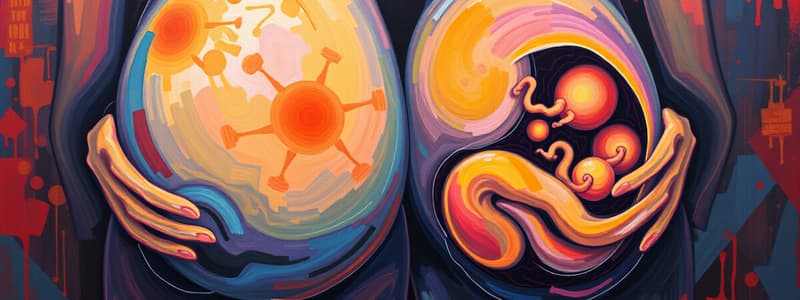Podcast
Questions and Answers
What is a defining feature of monozygotic twins?
What is a defining feature of monozygotic twins?
- They will always be of different genders.
- They are genetically identical. (correct)
- They are formed from two separate eggs.
- They are less likely to share a placental connection.
What characterizes dizygotic twins?
What characterizes dizygotic twins?
- They always share a placenta.
- They can only occur through assisted reproductive technologies.
- They are always of the same gender.
- They result from the fertilization of two separate eggs. (correct)
Which statement about the amnion is true?
Which statement about the amnion is true?
- It contains the amniotic fluid that protects the fetus. (correct)
- It does not play a role in fetal development.
- It is the outermost membrane surrounding the embryo.
- It always shares a blood supply with the chorion.
What does it mean for twins to be monochorionic?
What does it mean for twins to be monochorionic?
How does placentation differ between monozygotic and dizygotic twins?
How does placentation differ between monozygotic and dizygotic twins?
Which of the following is a method through which dizygotic twins can arise?
Which of the following is a method through which dizygotic twins can arise?
Which of the following is true about the chorion?
Which of the following is true about the chorion?
What is one of the implications of having dichorionic twins?
What is one of the implications of having dichorionic twins?
What is a primary reason for the increased risk of congenital abnormalities in monozygotic twins?
What is a primary reason for the increased risk of congenital abnormalities in monozygotic twins?
Which condition is amplified due to the physiological strains of twin pregnancies?
Which condition is amplified due to the physiological strains of twin pregnancies?
How does the size of the placenta impact the development of hypertensive disorders in twin pregnancies?
How does the size of the placenta impact the development of hypertensive disorders in twin pregnancies?
What is a common cause of gestational diabetes in twin pregnancies?
What is a common cause of gestational diabetes in twin pregnancies?
Which placental complication is more likely to occur in twin pregnancies?
Which placental complication is more likely to occur in twin pregnancies?
What condition related to twin pregnancies results from dilutional anemia?
What condition related to twin pregnancies results from dilutional anemia?
Which serious complications are twins at higher risk for due to increased blood volume?
Which serious complications are twins at higher risk for due to increased blood volume?
What factor often necessitates cesarean delivery in twin pregnancies?
What factor often necessitates cesarean delivery in twin pregnancies?
What is a significant risk of twin pregnancies related to fetal health?
What is a significant risk of twin pregnancies related to fetal health?
Why might a cesarean delivery be more likely in twin pregnancies?
Why might a cesarean delivery be more likely in twin pregnancies?
What condition should be monitored for due to its increased occurrence in twin pregnancies?
What condition should be monitored for due to its increased occurrence in twin pregnancies?
What is the primary reason for increased perinatal mortality in twin pregnancies?
What is the primary reason for increased perinatal mortality in twin pregnancies?
What nutritional consideration is critical for managing twin pregnancies?
What nutritional consideration is critical for managing twin pregnancies?
Which complication is specific to monochorionic twins that involves their blood circulation?
Which complication is specific to monochorionic twins that involves their blood circulation?
What factor increases the risk of intrauterine growth restriction (IUGR) in twin pregnancies?
What factor increases the risk of intrauterine growth restriction (IUGR) in twin pregnancies?
How does the number of fetuses affect gestational duration?
How does the number of fetuses affect gestational duration?
What is the primary nutritional concern during twin pregnancies?
What is the primary nutritional concern during twin pregnancies?
Which condition is unlikely to occur in twin pregnancies?
Which condition is unlikely to occur in twin pregnancies?
What is a key sign of twin-twin transfusion syndrome?
What is a key sign of twin-twin transfusion syndrome?
What is one of the risks associated with monochorionic twin pregnancies?
What is one of the risks associated with monochorionic twin pregnancies?
What complication can arise from sharing an amniotic sac in monoamniotic twins?
What complication can arise from sharing an amniotic sac in monoamniotic twins?
What is a major risk associated with monoamniotic twins?
What is a major risk associated with monoamniotic twins?
Which type of twin arrangement is considered the safest due to individual environments for each baby?
Which type of twin arrangement is considered the safest due to individual environments for each baby?
What does a significant size difference between twins on ultrasound indicate?
What does a significant size difference between twins on ultrasound indicate?
Which statement accurately describes the placental arrangement of dizygotic twins?
Which statement accurately describes the placental arrangement of dizygotic twins?
What does the term 'monozygotic' refer to?
What does the term 'monozygotic' refer to?
What condition is more likely if twins share a chorion?
What condition is more likely if twins share a chorion?
Why are non-stress tests (NST) performed more frequently in twin pregnancies?
Why are non-stress tests (NST) performed more frequently in twin pregnancies?
What type of twins generally have a fused placenta?
What type of twins generally have a fused placenta?
What is the primary purpose of corticosteroids in the management of twin pregnancies?
What is the primary purpose of corticosteroids in the management of twin pregnancies?
Which term describes a pregnancy with twins sharing both chorion and amniotic sac?
Which term describes a pregnancy with twins sharing both chorion and amniotic sac?
What is the risk associated with monochorionic diamniotic twins compared to dichorionic twins?
What is the risk associated with monochorionic diamniotic twins compared to dichorionic twins?
What is a common sign of maternal anemia in twin pregnancies?
What is a common sign of maternal anemia in twin pregnancies?
When can genetic testing be particularly beneficial in a twin pregnancy?
When can genetic testing be particularly beneficial in a twin pregnancy?
What does a monochorionic diamniotic arrangement imply for twins?
What does a monochorionic diamniotic arrangement imply for twins?
Flashcards are hidden until you start studying
Study Notes
Twin Pregnancies Overview
- Twin pregnancies involve two developing babies and can present additional risks for the fetuses and the pregnant individual.
- They can be categorized into monozygotic (identical) or dizygotic (fraternal) twins, based on zygote formation and placental development.
Monozygotic (Identical) Twins
- Formed from a single zygote that divides, usually in the first week of gestation, resulting in genetically identical embryos.
- Always the same gender due to shared genetic makeup.
- Look very similar due to sharing the same DNA.
Dizygotic (Fraternal) Twins
- Develop from two different eggs fertilized by separate sperm, making them genetically unique siblings.
- They can be the same or different genders.
- Often spontaneous but more commonly occur through assisted reproductive technologies like IVF.
Placental Types
- Amnion: Inner membrane that encapsulates the fetus and contains amniotic fluid for protection.
- Chorion: The outer membrane that forms the placenta, essential for nutrient and oxygen exchange.
Twin Placental Types
- Monochorionic: Twins share a single chorion, affecting blood supply.
- Dichorionic: Each twin has its own chorion, reducing complications associated with shared blood flow.
- Monoamniotic: Twins share an amniotic sac, increasing risk of cord entanglement.
- Diamniotic: Each twin has different amniotic sacs, offering better protection.
Monozygotic Twin Placental Configurations
- Dichorionic Diamniotic: Each twin has independent chorion and amniotic sac; safest arrangement with lower risk.
- Monochorionic Diamniotic: Shared chorion but separate amniotic sacs; increased risk of complications due to shared blood flow.
- Monochorionic Monoamniotic: Shared both chorion and amniotic sac; highest risk configuration for complications.
Dizygotic Twin Placental Configurations
- Fraternal twins are always dichorionic and diamniotic with individual placentas and sacs, minimizing risk of complications.
Signs and Symptoms
- Ultrasound may show anomalies indicating growth or placental issues.
- Increased risk of preterm birth and maternal anemia due to supporting two fetuses.
Lab Evaluation
- Ultrasound: Assesses fetal growth, placental sites, and congenital anomalies.
- Genetic Testing: Provides insights into potential complications early in the pregnancy.
- NSTs are conducted more frequently to monitor fetal well-being.
Management in Pregnancy
- Regular prenatal visits for monitoring due to higher risks in twin pregnancies.
- Corticosteroids may be administered to aid fetal lung maturity in case of anticipated premature birth.
- Nutritional consultations are important to support the increased demands of twin pregnancies.
Implications for Birth Type
- Higher likelihood of cesarean delivery due to complications like abnormal positioning or preeclampsia.
- Complexity of pregnancy raises the chance of needing cesarean interventions.
Risks to the Fetuses
- Increased perinatal morbidity and mortality due to space and nutrient competition.
- Higher risk factors include twin-twin transfusion syndrome and congenital defects.
- Preterm birth rates are significantly higher in twins, affecting overall health and growth.
Risks to the Pregnant Individual
- Complications such as gestational hypertension, diabetes, and anemia are amplified.
- The larger placenta in twin pregnancies can cause earlier and more severe hypertensive disorders.
- Increased risk of serious conditions including acute fatty liver and peripartum cardiomyopathy.
- Cesarean births are more common due to risks associated with both fetuses and the pregnant person.
Studying That Suits You
Use AI to generate personalized quizzes and flashcards to suit your learning preferences.





